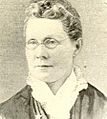National Association of Army Nurses of the Civil War facts for kids

"Our Women and the War" from Harper’s Weekly, September 6, 1862
|
|
| Predecessor | Ex-Nurse's Association of the District of Columbia, National Association of Army Nurses of the Late War |
|---|---|
| Formation | 18 June 1881 |
| Founder | Dorothea Dix |
| Founded at | Washington, D.C. |
| Legal status | Defunct |
| Purpose | Gain recognition for nurses who served in the US Civil War |
|
Key people
|
Harriet Patience Dame, Addie L. Ballou |
| Affiliations | Grand Army of the Republic |
The National Association of Army Nurses of the Civil War was a special group formed by women who had served as nurses during the American Civil War. It was a social club where they could meet, but it also worked hard to get these brave nurses the recognition and benefits they deserved.
Contents
Why Nurses Formed This Group
During the Civil War, over 3,000 women became nurses. They worked under the leadership of Dorothea Dix, who was the Superintendent of Army Nurses. Many of these women had no medical training before the war. They learned how to care for wounded soldiers right on the battlefield, which was very dangerous.
Sometimes, male army doctors weren't very welcoming to them. After the war, many of these nurses didn't receive any official thanks or money from the government for their important service. This is why they decided to form their own organization.
How the Association Started and Grew
The group began on June 18, 1881, thanks to Dorothea Dix. It was first called the "Ex-Nurse's Association of the District of Columbia." Its main goals were to help members find jobs, support them when they were sick, and honor the Union cause.
Dorothea Dix was chosen as the president for life. The group met every year in Washington D.C. Soon, they started meeting during the yearly reunions of Civil War veterans, called the National Encampments, which were held by the Grand Army of the Republic (G.A.R.).

By 1892, 35 members from all over the United States joined the meeting. Because of this, the group changed its name to the National Association of Army Nurses of the Late War.
After a short break, the group met again in 1895 in Louisville, Kentucky. In 1897, when they met in Buffalo, New York, they had about 500 members! They were then known as the National Army Nurses Association.
In 1899, the association met in Philadelphia during the G.A.R. encampment. Many officers attended, including Elizabeth W. Ewing, Kate M. Scott, and Fanny Titus Hazen. By 1901, the name changed again to National Association of Army Nurses of the Civil War. This was to make sure people knew they were nurses from the Civil War, not the Spanish-American War.
The organization continued its work until September 1931. By then, only five members were still alive, and the group officially ended.
Who Could Join and What They Gained
To become a member, a woman had to prove she had worked as a paid or volunteer nurse for at least three months during the Civil War. Their applications also needed approval from a local Grand Army of the Republic group.
Some famous members included Dorothea Dix, Clara Barton (who founded the American Red Cross), and "Mother" Bickerdyke.
Important Achievements: Benefits for Nurses
One of the biggest successes of this association was helping nurses get the recognition and benefits they had earned.
- Pensions:
In 1892, a law was passed that gave nurses who were hired and paid by the government a pension of $12 per month. However, many volunteer nurses still didn't receive pensions, even as late as 1910.
- National Cemetery Privileges:
Thanks to their efforts, all Civil War nurses were allowed to be buried in National Cemeteries. This was a great honor for their service.
Leaders of the Association
Many well-known Civil War nurses served as presidents of the association:
- Dorothea Dix (1881-1887)
- Dr. Susan Ann Edson (1887-?), who was one of the first women doctors in the U.S.
- Harriet Patience Dame
- Addie L. Ballou
- Emily E. Woodley (1895-1898)
- Elizabeth Wendell Ewing
- Ada Johnson
- Delia A.B. Fay
- Margaret Hamilton
- Fanny Titus Hazen
- Clarissa F. Dye
- Rebecca S. Smith
- Cornelia Hancock
- Mary E. Robey Lacey
- Rebecca Lane Pennypacker Price
- Alice Cary Risley (1915-1931)
External Resources
- "Annie Bell with patients after the Battle of Nashville, circa 1864" (U.S. Sanitary Commission photograph), in "Civil War Nurses," in "Civil War Women," in "Understanding War Through Imagery: The Civil War in American Memory." Carlisle, Pennsylvania: U.S. Army Heritage & Education Center, retrieved online May 16, 2018.
- Stearns, Amanda Akin. The Lady Nurse of Ward E. New York, New York: The Baker & Taylor Company, 1909.
- "The Diary of a Civil War Nurse." Washington, D.C.: Albert H. Small Documents Gallery, Smithsonian: National Museum of American History, retrieved online May 16, 2018.
Gallery
Presidents and other officers of the National Association of Army Nurses of the Civil War.
























